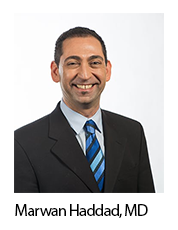March 27, 2024
New research from the Center for Key Populations, Community Health Center, Inc., the Weitzman Institute, and the Health Disparities Institute demonstrates that FQHC primary care settings can achieve impressive results treating patients with opioid use disorder.
Marwan Haddad, MD, medical director of the Center for Key Populations, led the observational, real-world study of 1,451 patients whose treatment at Community Health Center, a multi-site FQHC, took place over a period of nine years. His team’s study illustrates that opioid use disorder (OUD) treatment at an FQHC can be successfully achieved. Overall, patients continued with buprenorphine treatment for an average of over 2 years.
 The study is the first of its kind in terms of the number of people and the length of time studied. It is also unique for the way it assessed treatment gaps, defined as patients leaving treatment for more than 14 days. The majority of patients had a treatment gap, and the average length of a treatment gap was 33 days.
The study is the first of its kind in terms of the number of people and the length of time studied. It is also unique for the way it assessed treatment gaps, defined as patients leaving treatment for more than 14 days. The majority of patients had a treatment gap, and the average length of a treatment gap was 33 days.
Viewing gaps in care as reflective of the nature of a chronic relapsing disease, the authors continued to look at the data for people who periodically disappeared from treatment. They found a mean yearly patient retention of 69% when taking into account treatment gaps. The result is a richer picture of people’s engagement with care over a longer period of time.
“Primary care centers can be great access points for people in terms of treating opioid use disorder, curtailing the opioid crisis, and consequently, decreasing and preventing overdose and overdose deaths,” said lead author Dr. Haddad.
“Overdose deaths continue to rise from year to year, and we need more primary care centers involved in treating opioid use disorder,” he continued. “We have shown that it can be done, and done well, with a population that tends to be underserved. We want community health centers to know, this can be done in these settings. You can be extremely successful. You can engage people in care.”
Dr. Haddad, a primary care physician, specializes in working with patients with OUD, HIV, and other chronic diseases. Caring for patients with OUD, he said, requires that we meet patients where they are.
“We don’t stop treating patients with high blood pressure because they are not taking their blood pressure medication consistently, or patients with diabetes who eat too many sweets,” he explained. “OUD should not be any different. We’ve tried to convey the importance of fighting stigma and discrimination against people who use drugs and shifting the mindset to treat substance use like other chronic diseases.”
For the study, he noted, the team evaluated “over 56,000 toxicology screens, and we saw that over 91% tested positive for buprenorphine, 70% were negative for opioids, and 81% negative for cocaine. People take the medication when it is prescribed to them and it helps them achieve their treatment goals of decreasing or stopping their substance use.”
The study population consisted of 1,451 patients ages 18 and older who received at least one prescription from the buprenorphine program at Community Health Center Inc. (CHCI), a multi-site FQHC in Connecticut with 23 unique buprenorphine prescribers at 14 sites, between 2007-2016. The majority of CHCI patients are people of color (nearly 50% Hispanic; 15% Black). Approximately two-thirds of CHCI patients are Medicaid-insured, and 90% have income below 200% of the United States federal poverty level. Like most FQHCs, CHCI provides integrated medical, behavioral health, and dental services. CHCI is a part of the Moses/Weitzman Health System, where the Center for Key Populations and Weitzman Institute are also based.
Importantly, Dr. Haddad noted, CHCI has worked hard at shifting the culture and adopting a harm reduction approach, which he said is “key to keeping people engaged in care.”
Emil Coman, PhD, statistician at the Health Disparities Institute at the University of Connecticut School of Medicine, and Lauren Bilfulco, senior research associate at the Weitzman Institute, collaborated on the study with Dr. Haddad.
Their article, “Nine year substance use treatment outcomes with buprenorphine for opioid use disorder in a federally qualified health center,” appears in the April 2024 issue of Drug and Alcohol Dependence.
